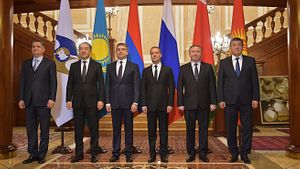As 2016 draws to a close, the Eurasian Economic Union will move into its third year. But three years on, the union remains a confusing and messy entity.
At a meeting of the Eurasian Intergovernmental Council — the prime ministers of the five member states plus the Eurasian Economic Commission chairman — the Kyrgyz Prime Minister Sooronbay Jeenbekov gripped over blocked access to the union’s common market.
After almost a year and a half (Kyrgyzstan officially acceded to the EEU in August 2015), “Kyrgyz products cannot get into the common market of the Eurasian Economic Union.” The issue is predominantly with Kazakhstan, the only other EEU state which borders Kyrgyzstan.
On paper, the EEU’s integrated single market spans five countries — Russia, Kazakhstan, Belarus, Armenia and Kyrgyzstan — encompassing more than 180 million people with a combined GDP of more than 4 trillion (PPP). While the union’s GDP in nominal terms has declined (from 2.4 trillion in 2013 to 1.6 trillion in 2015), reflecting the ruble’s collapse and a serious decline in oil prices, in PPP it continues to grow slowly. Regardless of the measurement used, Russia is the largest economy in the union and Kyrgyzstan is the smallest.
The Kyrgyz had high — perhaps too high — hopes about joining the union.
Kubat Rakhimov, an economist and former assistant minister, stressed in an interview with 24.kg that while the decision to join the EEU was the correct one, “any integration is not a magic wand.” Rakhimov says that Kyrgyz politicians “fell in love with a fictional image” of the EEU’s positive potential but lacked strategic vision. Political leaders urged Kyrgyz to buy goods — millions “spent on Japanese scrap and tasteless Chinese clothing” — with the union promising the ability to sell to Kazakhs, but “Kyrgyzstan became an ouroboros – the snake that bites its own tail. We were promised the moon. But in the end, when we have entered into the union, not counting all the risks, our own investment resources went into speculative capital.” Rakhimov says, focus should have been on building up production capabilities rather than banking on being able to re-sell low-quality goods — something blacked by the union’s standards and the Kazakh border.
“This situation can not continue indefinitely,” Jeenbekov said at the EEU meeting in Moscow. The Kyrgyz have been told to settle it bilaterally with Kazakhstan, which then pushes it back to the group — meanwhile, the benefits of belonging to a common market seem like snake oil lies.
At the same time, the EEU — driven primarily by Russia — seeks to brand itself as dynamic and growing. The prime ministers did adopt a draft customs code, expected to be signed by the five presidents at a December summit. And Russian Prime Minister Dmitry Medvedev has said the EEU is in discussions with “up to 40” countries on free trade agreements. The EEU’s first FTA went into effect in October with Vietnam, Moscow is eyeing Israel as a major future get. How beneficial will these FTAs be for Kyrgyzstan which is still not able to reliably export goods to its northern neighbor, Kazakhstan?

































